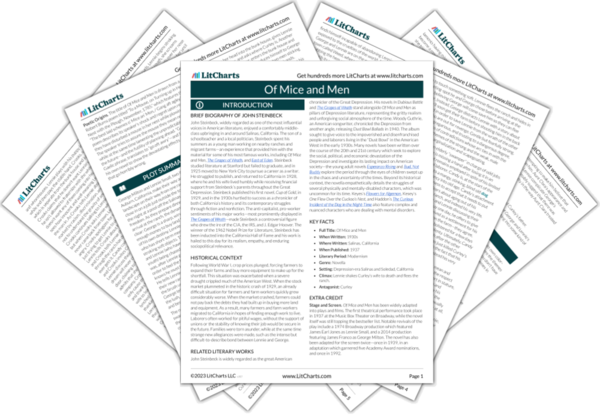Welcome to the LitCharts study guide on John Steinbeck's Of Mice and Men. Created by the original team behind SparkNotes, LitCharts are the world's best literature guides.
Of Mice and Men: Introduction
Of Mice and Men: Plot Summary
Of Mice and Men: Detailed Summary & Analysis
Of Mice and Men: Themes
Of Mice and Men: Quotes
Of Mice and Men: Characters
Of Mice and Men: Symbols
Of Mice and Men: Literary Devices
Of Mice and Men: Theme Wheel
Brief Biography of John Steinbeck

Historical Context of Of Mice and Men
Other Books Related to Of Mice and Men
- Full Title: Of Mice and Men
- When Written: 1930s
- Where Written: Salinas, California
- When Published: 1937
- Literary Period: Modernism
- Genre: Novella
- Setting: Depression-era Salinas and Soledad, California
- Climax: Lennie shakes Curley’s wife to death and flees the ranch.
- Antagonist: Curley
Extra Credit for Of Mice and Men
Stage and Screen. Of Mice and Men has been widely adapted into plays and films. The first theatrical performance took place in 1937 at the Music Box Theater on Broadway, while the novel itself was still topping the bestseller list. Notable revivals of the play include a 1974 Broadway production which featured James Earl Jones as Lennie Small, and a 2014 production featuring James Franco as George Milton. The novel has also been adapted for the screen twice—once in 1939, in an adaptation which garnered five Academy Award nominations, and once in 1992.
Poetic Origins. The title of Of Mice and Men is drawn from a Robert Burns poem titled “To a Mouse, on Turning up in Her Nest with the Plough, November, 1785,” which features the line “The best laid schemes o’ Mice an’ Men, / Gang aft agley.” The poem describes its speaker’s shock and regret upon realizing they have disturbed a mouse in her nest while plowing a field. The speaker tries to assure the mouse they mean no harm while at the same time lamenting the unpredictable nature of the future—and the futility of planning ahead. “Gang aft agley,” a Gaelic phrase, translates to “go oft awry”—and Steinbeck uses his own novel to show the devastating effects of future plans that go horribly wrong.







